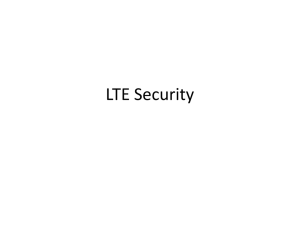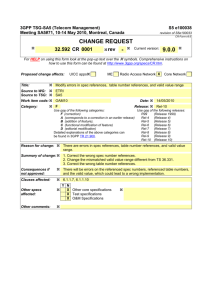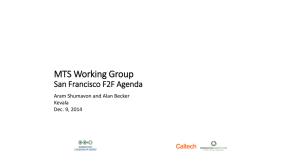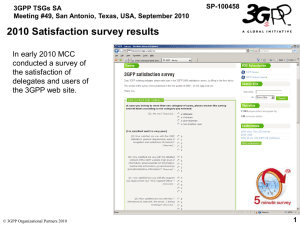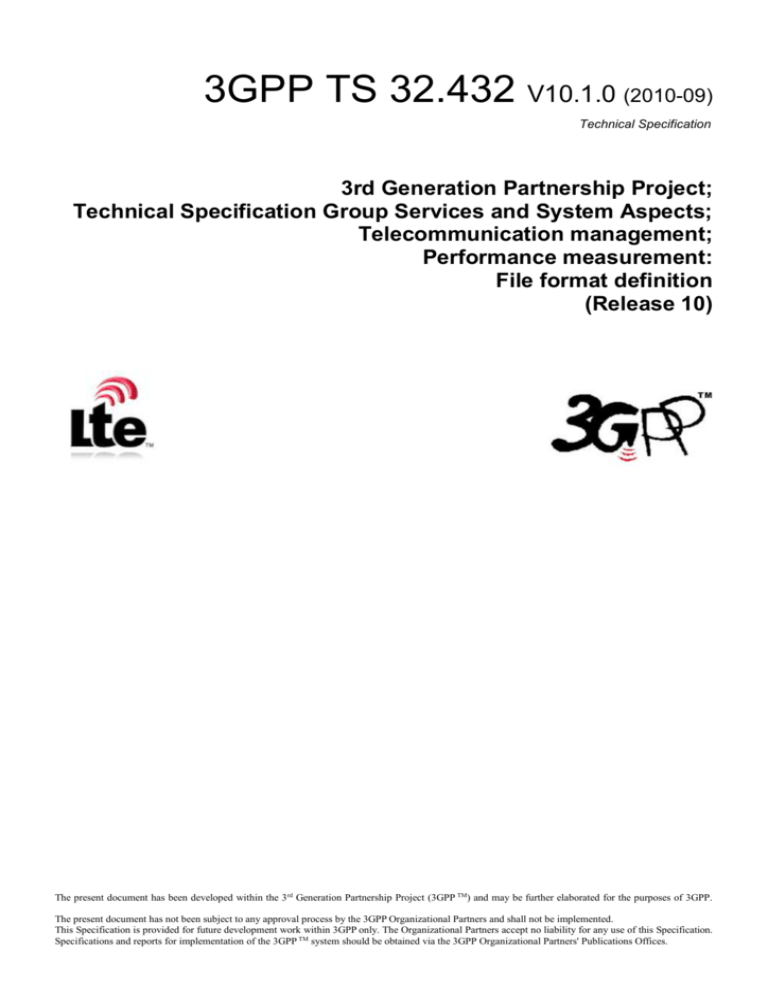
3GPP TS 32.432 V10.1.0 (2010-09)
Technical Specification
3rd Generation Partnership Project;
Technical Specification Group Services and System Aspects;
Telecommunication management;
Performance measurement:
File format definition
(Release 10)
The present document has been developed within the 3 rd Generation Partnership Project (3GPP TM) and may be further elaborated for the purposes of 3GPP.
The present document has not been subject to any approval process by the 3GPP Organizational Partners and shall not be implemented.
This Specification is provided for future development work within 3GPP only. The Organizational Partners accept no liability for any use of this Specification.
Specifications and reports for implementation of the 3GPP TM system should be obtained via the 3GPP Organizational Partners' Publications Offices.
(Release 10)
2
3GPP TS 32.432 V10.1.0 (2010-09)
Keywords
UMTS, management, performance
3GPP
Postal address
3GPP support office address
650 Route des Lucioles - Sophia Antipolis
Valbonne - FRANCE
Tel.: +33 4 92 94 42 00 Fax: +33 4 93 65 47 16
Internet
http://www.3gpp.org
Copyright Notification
No part may be reproduced except as authorized by written permission.
The copyright and the foregoing restriction extend to reproduction in all media.
©2010, 3GPP Organizational Partners (ARIB, ATIS, CCSA, ETSI, TTA, TTC).
All rights reserved.
UMTS™ is a Trade Mark of ETSI registered for the benefit of its members
3GPP™ is a Trade Mark of ETSI registered for the benefit of its Members and of the 3GPP Organizational Partners
LTE™ is a Trade Mark of ETSI currently being registered for the benefit of its Members and of the 3GPP Organizational Partners
GSM® and the GSM logo are registered and owned by the GSM Association
3GPP
(Release 10)
3
3GPP TS 32.432 V10.1.0 (2010-09)
Contents
Foreword............................................................................................................................................................. 4
Introduction ........................................................................................................................................................ 4
1
Scope ........................................................................................................................................................ 5
2
References ................................................................................................................................................ 5
3
Definitions and abbreviations................................................................................................................... 5
3.1
3.2
4
4.1
5
5.1
5.1.1
5.1.1.1
5.1.1.2
5.1.2
5.2
Definitions ......................................................................................................................................................... 5
Abbreviations ..................................................................................................................................................... 6
Measurement Report File Format ............................................................................................................ 6
File Content description ..................................................................................................................................... 7
Measurement Report File Conventions and Transfer Procedure ............................................................. 9
Conventions ....................................................................................................................................................... 9
File generation .............................................................................................................................................. 9
NE based approach ................................................................................................................................. 9
EM based approach ................................................................................................................................ 9
File naming................................................................................................................................................. 10
File transfer procedure ..................................................................................................................................... 11
Annex A (informative):
A.1
The table oriented file format structure ...................................................... 12
Graphical representation of the table structure....................................................................................... 12
Annex B (informative):
Change history ............................................................................................... 13
3GPP
(Release 10)
4
3GPP TS 32.432 V10.1.0 (2010-09)
Foreword
This Technical Specification has been produced by the 3 rd Generation Partnership Project (3GPP).
The contents of the present document are subject to continuing work within the TSG and may change following formal
TSG approval. Should the TSG modify the contents of the present document, it will be re-released by the TSG with an
identifying change of release date and an increase in version number as follows:
Version x.y.z
where:
x the first digit:
1 presented to TSG for information;
2 presented to TSG for approval;
3 or greater indicates TSG approved document under change control.
y the second digit is incremented for all changes of substance, i.e. technical enhancements, corrections,
updates, etc.
z the third digit is incremented when editorial only changes have been incorporated in the document.
Introduction
The present document is part of a TS-family covering the 3rd Generation Partnership Project: Technical Specification
Group Services and System Aspects; Telecommunication management, as identified below:
TS 32.432:
“Performance measurement; File format definition";
TS 32.435:
"Performance measurement; eXtensible Markup Language (XML) file format definition";
TS 32.436:
"Performance measurement; Abstract Syntax Notation 1 (ASN.1) file format definition".
The present document is part of a set of specifications, which describe the requirements and information model
necessary for the standardised Operation, Administration and Maintenance (OA&M) of a multi-vendor 3G PLMN.
During the lifetime of a PLMN, its logical and physical configuration will undergo changes of varying degrees and
frequencies in order to optimise the utilisation of the network resources. These changes will be executed through
network configuration management activities and/or network engineering, see 3GPP TS 32.600 [4].
Many of the activities involved in the daily operation and future network planning of a PLMN network require data on
which to base decisions. This data refers to the load carried by the network and the grade of service offered. In order to
produce this data performance measurements are executed in the NEs, which comprise the network. The data can then
be transferred to an external system, e.g. an Operations System (OS) in TMN terminology, for further evaluation. The
purpose of the present document and the other related 3GPP TSs listed above is to describe the mechanisms involved in
the collection of the data.
3GPP
(Release 10)
1
5
3GPP TS 32.432 V10.1.0 (2010-09)
Scope
The present document describes the general semantics of performance measurement result and collection. It defines the
report file format, report file conventions and the file transfer procedure. Clause 4 specifies the file format for the bulk
transfer of performance measurement results to the NM, while clause 6 discusses the file transfer procedure utilised on
that interface.
The present document does not give the definition of any specific file format – such as XML and ASN.1, which will be
given in Performance Measurement eXtensible Markup Language (XML) File Format Definition 3GPP TS 32.435 and
Performance Measurement Abstract Syntax Notation 1 (ASN.1) File Format Definition 3GPP TS 32.436.
2
References
The following documents contain provisions which, through reference in this text, constitute provisions of the present
document.
References are either specific (identified by date of publication, edition number, version number, etc.) or
non-specific.
For a specific reference, subsequent revisions do not apply.
For a non-specific reference, the latest version applies. In the case of a reference to a 3GPP document (including
a GSM document), a non-specific reference implicitly refers to the latest version of that document in the same
Release as the present document.
[1]
3GPP TS 32.101: "Telecommunication management; Principles and high level requirements".
[2]
3GPP TS 32.102: "Telecommunication management; Architecture".
[3]
3GPP TS 32.401: "Telecommunication management; Performance Management (PM); Concept
and requirements".
[4]
3GPP TS 32.600: "Telecommunication management; Configuration Management (CM); Concept
and high-level requirements".
[5]
3GPP TS 25.442: "UTRAN Implementation Specific O&M Transport".
[6]
3GPP TS 32.300: "Telecommunication management; Configuration Management (CM); Name
convention for Managed Objects".
[7]
3GPP TS 52.402: "Telecommunication management; Performance Management (PM);
Performance measurements - GSM".
[8]
3GPP TS 32.403: "Telecommunication management; Performance Management (PM);
Performance measurements - UMTS and combined UMTS/GSM".
[9]
3GPP TS 32.622: "Telecommunication management; Configuration Management (CM); Generic
network resources Integration Reference Point (IRP): Network Resource Model (NRM)".
[10]
ITU-T Recommendation X.680: "Information technology - Abstract Syntax Notation One
(ASN.1): Specification of basic notation".
[11]
ISO8601:2000(E) Data elements and interchange formats – Information interchange –
Representation of dates and times".
3
Definitions and abbreviations
3.1
Definitions
For the purposes of the present document, the following terms and definitions apply:
3GPP
(Release 10)
6
3GPP TS 32.432 V10.1.0 (2010-09)
network Element Manager (EM): provides a package of end-user functions for management of a set of closely related
types of Network Elements. These functions can be divided into two main categories:
-
Element Management Functions for management of Network Elements on an individual basis. These are
basically the same functions as supported by the corresponding local terminals.
-
Sub-Network Management Functions that are related to a network model for a set of Network Elements
constituting a clearly defined sub-network, which may include relations between the Network Elements. This
model enables additional functions on the sub-network level (typically in the areas of network topology
presentation, alarm correlation, service impact analysis and circuit provisioning).
Network Manager (NM): provides a package of end-user functions with the responsibility for the management of a
network, mainly as supported by the EM(s) but it may also involve direct access to the Network Elements. All
communication with the network is based on open and well-standardised interfaces supporting management of multivendor and multi-technology Network Elements.
Operations System (OS): generic management system, independent of its location level within the management
hierarchy.
3.2
Abbreviations
For the purposes of the present document, the following abbreviations apply:
3G
EM
GSM
NE
NM
PM
4
3rd Generation
Element Manager
Global System for Mobile communications
Network Element
Network Manager
Performance Management
Measurement Report File Format
This clause describes the format of measurement result files that can be transferred from the network (NEs or EM) to
the NM.
The following conditions have been considered in defining this file format:
Since the files are transferred via a machine-machine interface, the files applying the format definitions should
be machine-readable using standard tools.
The file format should be independent of the data transfer protocol used to carry the file from one system to
another.
The file format should be generic across 3G systems.
The file format should be flexible enough to include all possible measurement types, i.e. those specified within
clause 6 as well as measurements defined within other standards bodies, or vendor specific measurement types.
The file format should not impose any dependency between granularity periods for the generation of
measurement results and file upload cycles for the file transfer from the network to the NM.
The file format should be flexible enough to support both the NE-based and the EM-based approaches, as
discussed in Chapter 5, clause 5.1.1 of the present document.
The file format should be usable for other interfaces than Itf-N if required. The measurement file header could be
augmented to indicate this other usage, however this would be a non-standard extension. In the ASN.1 (see ITUT Recommendation X.680 [10]) file format definition this is accommodated by the use of the ellipsis notation.
XML schema allows such additions through insertion of extra schema elements through the provider of the nonstandard extension.
3GPP
(Release 10)
4.1
7
3GPP TS 32.432 V10.1.0 (2010-09)
File Content description
Table 4.1 lists all the file content items. It also provides an explanation of the individual items.
Table 4.1 File Content Description
File Content Item
measDataCollection
Description
This is the top-level tag, which identifies the file as a collection of measurement data. The file
content is made up of a header ("measFileHeader"), the collection of measurement result items
("measData"), and a measurement file footer ("measFileFooter").
measFileHeader
This is the measurement result file header to be inserted in each file. It includes a version
indicator, the name, type and vendor name of the sending network node, and a time stamp
("collectionBeginTime").
measData
The "measData" construct represents the sequence of zero or more measurement result items
contained in the file. It can be empty in case no measurement data can be provided. The
individual "measData" elements can appear in any order.
Each "measData" element contains the name of the NE ("nEId") and the list of measurement
results pertaining to that NE ("measInfo").
measFileFooter
The measurement result file footer to be inserted in each file. It includes a time stamp, which
refers to the end of the overall measurement collection interval that is covered by the collected
measurement results being stored in this file.
fileFormatVersion
This parameter identifies the file format version applied by the sender. The format version defined
in the present document shall be the abridged number and version of this 3GPP document (see
below).
The abridged number and version of a 3GPP document is constructed from its version specific full
reference "3GPP […] (yyyy-mm)" by:
- removing the leading "3GPP TS"
- removing everything including and after the version third digit, representing editorial only
changes, together with its preceding dot character
- from the resulting string, removing leading and trailing white space, replacing every multi
character white space by a single space character and changing the case of all characters to
uppercase.
senderName
The senderName uniquely identifies the NE or EM that assembled this measurement file by its
Distinguished Name (DN), according to the definitions in 3GPP TS 32.300 [6]. In the case of the
NE-based approach, it is identical to the sender's "nEDistinguishedName".
senderType
This is a user configurable identifier of the type of network node that generated the file, e.g.
NodeB, EM, SGSN. The string may be empty (i.e. string size =0) in case the "senderType" is not
configured in the sender.
vendorName
The "vendorName" identifies the vendor of the equipment that provided the measurement file. The
string may be empty (i.e. string size =0) if the "vendorName" is not configured in the sender.
collectionBeginTime
The "collectionBeginTime" is a time stamp that refers to the start of the first measurement
collection interval (granularity period) that is covered by the collected measurement results that
are stored in this file.
neId
The unique identification of the NE in the system. It includes the user name ("nEUserName"), the
distinguished name ("nEDistinguishedName") and the software version ("nESoftwareVersion") of
the NE.
neUserName
This is the user definable name ("userLabel") defined for the NE in 3GPP TS 32.622 [9]. The
string may be empty (i.e. string size =0) if the "nEUserName" is not configured in the CM
applications.
neDistinguishedName This is the Distinguished Name (DN) defined for the NE in 3GPP TS 32.300 [6]. It is unique across
an operator's 3G network. The string may be empty (i.e. string size =0) if the
"nEDistinguishedName" is not configured in the CM applications.
neSoftwareVersion
This is the software version ("swVersion") defined for the NE in 3GPP TS 32.622 [9].
This is an optional parameter which allows post-processing systems to take care of vendor
specific measurements modified between software versions.
measInfo
The sequence of measurements, values and related information. It includes a list of measurement
types ("measTypes") and the corresponding results ("measValues"), together with the time stamp
("measTimeStamp") and granularity period ("granularityPeriod") pertaining to these
measurements.
This attribute associates a tag name with the set of measurements defined by a measInfo
measInfoId
property. This is an optional parameter that may be used to assign unique names to categories of
measurements grouped together by measInfo elements. It allows parsing tools to easily isolate
measurement sets by name.
measTimeStamp
Time stamp referring to the end of the granularity period.
jobId
The "jobId" represents the job with which measurement result contained in the file is associated.
The "jobId" is mandatory when PMIRP is supported.
granularityPeriod
Granularity period of the measurement(s) in seconds.
3GPP
(Release 10)
File Content Item
reportingPeriod
measTypes
measValues
measObjInstId
measResults
suspectFlag
timestamp
8
3GPP TS 32.432 V10.1.0 (2010-09)
Description
Reporting period of the measurement(s) in seconds.
The "reportingPeriod" is mandatory when PMIRP is supported.
This is the list of measurement types for which the following, analogous list of measurement
values ("measValues") pertains. The GSM only measurement types are defined in TS 52.402 [7].
The measurement types for UMTS and combined UMTS/GSM implementations are specified in
TS 32.403 [8].
This parameter contains the list of measurement results for the resource being measured, e.g.
trunk, cell. It includes an identifier of the resource ("measObjInstId"), the list of measurement result
values ("measResults") and a flag that indicates whether the data is reliable ("suspectFlag").
The "measObjInstId" field contains the local distinguished name (LDN) of the measured object
within the scope defined by the "nEDistinguishedName" (see 3GPP TS 32.300 [6]). The
concatenation of the "nEDistinguishedName" and the "measObjInstId" yields the DN of the
measured object. The "measObjInstId" is therefore empty if the "nEDistinguishedName" already
specifies completely the DN of the measured object, which is the case for all measurements
specified on NE level. For example, if the measured object is a "ManagedElement" representing
RNC "RNC-Gbg-1", then the "nEDistinguishedName" will be for instance
"DC=a1.companyNN.com,SubNetwork=1,IRPAgent=1,SubNetwork=CountryNN,MeContext=MECGbg-1,ManagedElement=RNC-Gbg-1", and the "measObjInstId" will be empty. On the other hand,
if the measured object is a "UtranCell" representing cell "Gbg-997" managed by that RNC, then
the "nEDistinguishedName" will be for instance the same as above, i.e.
"DC=a1.companyNN.com,SubNetwork=1,IRPAgent=1,SubNetwork=CountryNN,MeContext=MECGbg-1,ManagedElement=RNC-Gbg-1", and the "measObjInstId" will be for instance
"RncFunction=RF-1,UtranCell=Gbg-997". The class of the "measObjInstId" is defined in item F of
each measurement definition template.
This parameter contains the sequence of result values for the observed measurement types. The
"measResults" sequence shall have the same number of elements, which follow the same order
as the measTypes sequence. Normal values are INTEGERs and REALs. The NULL value is
reserved to indicate that the measurement item is not applicable or could not be retrieved for the
object instance.
Used as an indication of quality of the scanned data. FALSE in the case of reliable data, TRUE if
not reliable. The default value is "FALSE", in case the suspect flag has its default value it may be
omitted.
This tag carries the time stamp that refers to the end of the measurement collection interval
(granularity period) that is covered by the collected measurement results that are stored in this file.
The minimum required information within timestamp is year, month, day, hour, minute, and
second.
The measInfo contains the sequence of measurements, values and related information, in a table-oriented structure.
A graphical representation of this structure can be found in clause 6.1.
The representation of all timestamps in PM files shall follow the representations allowed by the ISO 8601 [11].
The precise format for timestamp representation shall be determined by the technology used for encoding the PM file
(e.g. ASN.1, XML DTD, XML Schema). The choice of technology should ensure that this representation is derived
from ISO 8601 [11]. Based on the representation used, the timestamp shall refer to either UTC time or local time or
local time with offset from UTC.
At least for those measurement types that are re-used from non-3GPP standards (e.g. IP, ATM), it is required that the
measType be operator definable. This is necessary to allow the operator to harmonise the numbering between different
vendors' systems where appropriate. Through this harmonisation, it can be assured that identical measurements always
carry the same measType value, which is required by the post-processing system. This requirement will eventually be
reflected in TS 52.402 [7] and TS 32.403 [8], which specify the performance measurements for GSM (TS 52.402 [7])
and UMTS and combined UMTS/GSM systems (TS 32.403 [8]).
3GPP
(Release 10)
5
9
3GPP TS 32.432 V10.1.0 (2010-09)
Measurement Report File Conventions and Transfer
Procedure
This clause describes the conventions how files containing performance measurement results are generated in the
network (EM or NEs) and the procedure to transfer these files from the network to the NM.
5.1
Conventions
The following clauses define conventions for the generation and the naming of measurement-result files.
5.1.1
File generation
Since vendors may choose to implement the NM interface either in the NEs or the EM, the measurement result files for
collection by the NM (push or pull transfer mechanism) may be provided by the NEs or the EM. Note that within one
3G network both possibilities may occur, since NEs of different types may use either one of the two possible
approaches (NE based or EM based). This is particularly true in a multi-vendor network.
The procedures for the transfer of the files to the NM from either the NE or the EM are described in clause 5.2.
5.1.1.1
NE based approach
The NE shall generate one measurement report(measurement record) immediately at the end of each granularity period.
This measurement report shall contain all measurement results produced by the NE within that granularity period. For
example, if a NodeB runs 10 measurements with a granularity period of 15 minutes and 5 measurements with a
granularity period of 5 minutes, then it shall generate one measurement report containing 10 results every 15 minutes,
and one measurement reportcontaining 5 measurement results every 5 minutes.
In the event of two or more granularity periods coming to an end at the same time, the NE shall generate one
measurement report per granularity period. Hence in the above example, the NodeB shall generate 2 measurement
reports – one containing 10 results (15min granularity period) and the other containing 5 measurement results (5 min
granularity period), when the end time of the granularity periods coincide.
Measurement reports (measurement record) of a particular granularity period are assembled into measurement result
file for transfer, e.g. from the NE or EM. The number of measurement reports assembled is based on reporting period.
The different types of measurement result file that can be supported are in section 5.1.2.
The NE shall be identified both in the file name and in the file contents. NE identifiers (names) used for the files shall
be in accordance with the NE naming conventions defined in 3GPP TS 32.300 [6]. The file shall be available for
transfer as soon as all applicable results have been assembled.
Each NE is responsible for the generation and maintenance of the measurement reports (measurement record)
pertaining to its own measurements (i.e. the measurements it executes). In particular, this implies that the RNC is not
involved in the generation, provision or transfer of measurement result files of its controlled NodeBs, i.e. for the
measurements defined for the NodeB in the present document, no results will be sent via the Iub interface. (Note that
NodeB measurement results may be routed across the same physical interface as Iub, see 3GPP TS 25.442 [5] for
details).
5.1.1.2
EM based approach
This approach requires that measurement results be forwarded to the EM according to the mechanisms described in
clause 4.2.4 of the 3GPP TS 32.401[3]. The EM may choose to provide measurement result files as described above for
the NEs, however, additional flexibility may be offered. For example, measurement results from several granularity
periods and/ or several NEs could be written into one single file. These NEs may be determined based on network
hierarchy (e.g. all NodeBs controlled by the same RNC, all NEs controlled by the same EM), or management domains
configured by the system operator (e.g. NodeBs belonging to a certain (management or geographical) area). In case
such rules are applied by the EM for the routing of measurement results to specific files then they shall be operator
configurable. If results from more than one NE are contained in a file, the NE identifier used for the file shall be the EM
name as defined in 3GPP TS 32.300 [6], or a domain name configured by the system operator. If results from more than
one granularity period are contained in the file then the beginning of the first and the end of the last granularity period
shall be indicated in the file name.
3GPP
(Release 10)
10
3GPP TS 32.432 V10.1.0 (2010-09)
The file shall be made available for transfer to or collection by the NM as soon as all applicable results have been
assembled.
5.1.2
File naming
The following convention shall be applied for measurement result file naming:
<Type><Startdate>.<Starttime>-[<Enddate>.]<Endtime>[_-<jobId>][_<UniqueId>][_-_<RC>]
1) The Type field indicates if the file contains measurement results for single or multiple NEs and/or granularity
periods where:
-
"A" means single NE, single granularity period; ( this is used when granularity period is equal to reporting
period )
-
"B" indicates multiple NEs, single granularity period; ( this is used when granularity period is equal to
reporting period)
-
"C" signifies single NE, multiple granularity periods; (this is used when reporting period is multiples of the
granularity period and will contain multiple measurement reports )
-
"D" stands for multiple NEs, multiple granularity periods. (this is used when reporting period is multiples of
the granularity period and will contain multiple measurement reports).
2) The Startdate field indicates the date when the granularity period began if the Type field is set to A or B. If the
Type field is either "C" or "D" then Startdate contains the date when the first granularity period of the
measurement results contained in the file started. The Startdate field is of the form YYYYMMDD, where:
-
YYYY is the year in four-digit notation;
-
MM is the month in two digit notation (01 - 12);
-
DD is the day in two-digit notation (01 - 31).
3) The Starttime field indicates the time when the granularity period began if the Type field is set to A or B. If the
Type field is either "C" or "D" then Starttime contains the time when the first granularity period of the
measurement results contained in the file began. The Starttime field is of the form HHMMshhmm, where:
-
HH is the two-digit hour of the day (local time), based on 24-hour clock (00 - 23);
-
MM is the two digit minute of the hour (local time), possible values are 00, 05, 10, 15, 20, 25, 30, 35, 40, 45,
50, and 55;
-
s is the sign of the local time differential from UTC (+ or -), in case the time differential to UTC is 0 then the
sign may be arbitrarily set to "+" or "-";
-
hh is the two-digit number of hours of the local time differential from UTC (00-23);
-
mm is the two digit number of minutes of the local time differential from UTC (00-59).
4) The Enddate field shall only be included if the Type field is set to "C" or "D", i.e. measurement results for
multiple granularity periods are contained in the file. It identifies the date when the last granularity period of
these measurements ended, and its structure corresponds to the Startdate field.
5) The Endtime field indicates the time when the granularity period ended if the Type field is set to A or B. If the
Type field is either "C" or "D" then Endtime contains the time when the last granularity period of the
measurement results contained in the file ended. Its structure corresponds to the Starttime field, however, the
allowed values for the minute of the hour are 05, 10, 15, 20, 25, 30, 35, 40, 45, 50, 55, and 00.
6) UniqueId. This is the name of the NE, EM or domain, as defined in clauses 5.1.1.1 and 5.1.1.2 (e.g. a
distinguishedName). The field may be omitted only if the distinguishedName is not available from the CM
applications.
7) The RC parameter is a running count, starting with the value of "1", and shall be appended only if the filename is
otherwise not unique, i.e. more than one file is generated and all other parameters of the file name are identical.
Therefore it may only be used by the EM, since the described situation cannot occur with NE generated files.
3GPP
(Release 10)
11
3GPP TS 32.432 V10.1.0 (2010-09)
Note that the delimiter for this field, _-_, is an underscore character (_), followed by a minus character (-),
followed by an underscore character (_).
8) jobId. When PMIRP is supported, the jobId shall be indicated in the performance measurement file name.
Some examples describing file-naming convention:
1) file name: A20000626.2315+0200-2330+0200_NodeBId,
meaning: file produced by NodeB <NodeBId> on June 26, 2000, granularity period 15 minutes from 23:15 local
to 23:30 local, with a time differential of +2 hours against UTC.
2) file name: B20021224.1700-1130-1705-1130_-job10_EMId,
meaning: file containing results for multiple NEs, generated for measurement job job10, produced by EM
<EMId> on December 24, 2002, granularity period 5 minutes from 17:00 local to 17:05 local, with a time
differential of –11:30 hours against UTC.
3) file name: D20050907.1030+0000-20050909.1500+0000_DomainId_-_2,
meaning: file containing results for NEs belonging to domain <DomainId>, start of first granularity period 07
September 2005, 10:30 local, end of last granularity period 09 September 2005, 15:00 local, with a time
differential of 0 against UTC. This file is produced by the EM managing the domain, and it is the second file for
this domain/granularity period combination.
4) file name: C20050907.1030+0000-20050909.1500+0000_NodeId,
meaning: file produced by the Node <NodeId> , start of first granularity period 07 September 2005, 10:30 local,
end of last granularity period 09 September 2005, 15:00 local, with a time differential of 0 against UTC.
5.2
File transfer procedure
Both push (i.e. triggered by the NE) and pull (triggered by the OS) transfer modes shall be supported on the NM
interface. Implementation specific means may be employed for the administration and control of the file transfer,
concerning:
-
the time of the transfer (in push mode);
-
the routing of the transfer to one or more OS(s) (in push mode);
-
the storage/deletion of the files in the NE, particularly when the EM based approach is chosen (cf.
clause 5.1.1.2).
Measurement result files shall be retained by the file generator (i.e. NE or EM) at least until they have been successfully
transferred to or collected by the NM. The storage capacity and the duration for which the data can be retained at the
NE or the EM will be Operator and implementation dependent.
The file transfer procedure implemented in the system (NE or EM) shall ensure that no data can get lost under normal
operating conditions. The procedure shall also ensure that the files will be deleted after successful transfer to the NM.
Depending on the exact implementation of the procedure, the NM may be responsible for deleting those files, or older
files will be eventually overwritten by new ones by the file generator in a round robin fashion.
Each implementation shall support all primitives of the selected protocol (e.g. put file, get file, inspect directory
contents, delete file) which are needed by the NM. These primitives depend on the details of the procedure, as defined
by the manufacturer.
3GPP
(Release 10)
12
3GPP TS 32.432 V10.1.0 (2010-09)
Annex A (informative):
The table oriented file format structure
Measurement Items (counters) are typically grouped according functionality (cf. 3GPP TS 52.402 [7] Measurement
Function). The term "measured object class" is used to identify such a group. The file format is based on the fact that
the measurements are always collected in sets of one functional group.
The measInfo contains the sequence of measurements, values and related information, in a table-oriented structure.
It includes a list of measurement types ("measTypes") and the corresponding values ("measValues"), together with the
time stamp ("measTimeStamp"), granularity period ("granularityPeriod") and reporting period ("reportingPeriod")
pertaining to these measurements. Whenever one of these 4 elements changes, then a new measInfo sequence is started.
If the "measTypes" change, then also the "measValues" change, because these elements are connected in the following
way: the "measTypes" correspond to a specific measurement object (NE, trunk, cell, …), of which one or more
instances can exist inside the NE.
Hence for one set of "measTypes", there can be one or more sets of "measValues", according to the "measObjInstId".
The above is best explained with an example: consider the CELL measurement function (3GPP TS 52.402 [7]). Then
the measured object class is Cell. The measInfo contains a "header" line defining which measurements related to Cell
are collected (measTypes), and in which order. The subsequent "data" lines will then contain the values of the
measurements for each specific cell, which is measured, one data line per cell (measValues).
This format will generate a kind of table with as column headings the measurement names, and in the rows the
corresponding measurement values per measured instance.
A.1
Graphical representation of the table structure
For clarity, the table in the example below only contains the measTypes and measValues (and suspectFlag), not the
granularityPeriod, reportingPeriod and the measTimeStamp.
cell=997
cell=998
cell=999
attTCHSeizures succTCHSeizures attImmediateAssignProcs succImmediateAssignProcs
234
345
567
789
false
890
901
123
234
false
456
567
678
789
false
3GPP
(Release 10)
13
3GPP TS 32.432 V10.1.0 (2010-09)
Annex B (informative):
Change history
Change history
Date
Sep
2004
Dec
2004
Mar
2005
Sep
2005
Dec
2008
Dec
2009
Mar
2010
Sep
2010
TSG # TSG
Doc.
S_25 SP040578
S_26 SP040786
SA_27 SP050040
SA_29 SP050585
SA_42 --
CR
Rev Subject/Comment
Cat
Old
--
--
--
1.0.0
--
--
Draft created based on 32.401 V6.1.0 and submitted to SA#25 for
Information
Submitted to SA#26 for Approval
--
2.0.0
6.0.0
0001 --
Resolve ambiguity in the format for timestamps in PM files
A
6.0.0
6.1.0
0002 1
Enhance PM XML file format with measInfo
C
6.1.0
7.0.0
--
--
Upgrade to Release 8
--
7.0.0
8.0.0
SA_46 --
--
--
Upgrade to Release 9
--
8.0.0
9.0.0
SA_47 SP100036
SA_49 SP100488
0003 --
Correct reference to non-existing annex.
D
9.0.0
10.0.0
0004 --
Remove restriction from PM file type for NE
F
10.0.0 10.1.0
3GPP
New


